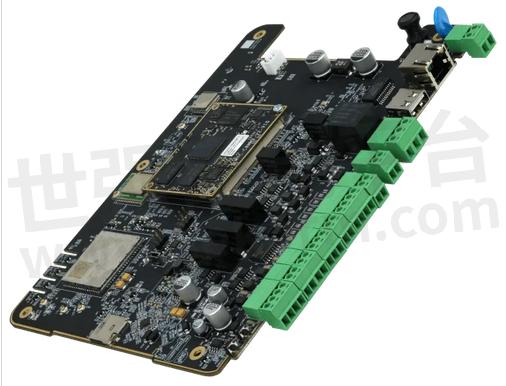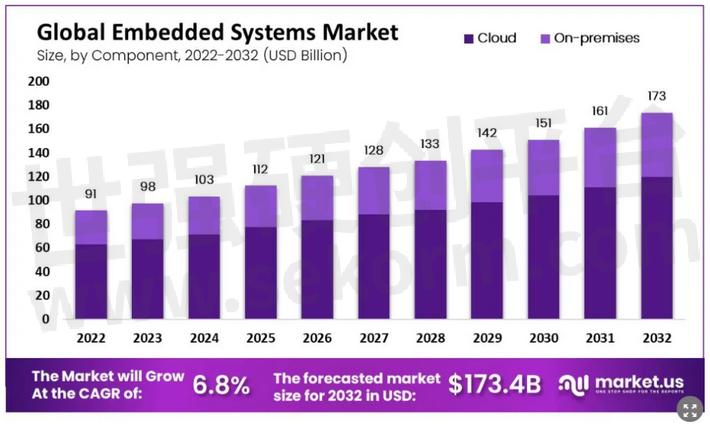Unveil IoT Embedded Systems: Accelerating Your IoT Development

IoT embedded systems, often unseen and hidden in the devices we use daily, play a pivotal role in enabling communication, data exchange, and intelligent decision-making in diverse industries and domains.

This article delves into IoT embedded systems, describes their basic functionality, and explains their key components. It will also enlighten you with some daily life products powered by IoT embedded systems. In the end, it provides a comprehensive guideline on how to fast-track the development of IoT embedded systems.
What is IoT?
IoT, or the Internet of Things, refers to the network of interconnected physical objects or “things” embedded with sensors, software, and other technologies. IoT systems often collect, exchange, and act upon data without direct human intervention. In our life, IoT is everywhere, such as smart thermostats, wearable fitness trackers, and voice-controlled smart assistants.
What are Embedded Systems?
Embedded systems are specialized computer systems designed to perform specific tasks or functions within a larger system, often with real-time constraints, minimal user interaction, and dedicated hardware and software components. A few practical examples of embedded systems from our daily life include anti-lock braking systems (ABS), airbag controllers, Heart rate monitors, smart TVs, etc.
What Makes IoT Embedded Systems Different?
IoT embedded systems differ by fusing traditional embedded systems with internet connectivity, enabling devices to share data beyond their immediate environment. They’re like “smart” puzzle pieces that gather information and communicate online, offering enhanced remote control, automation, and data-driven insights for optimized functionality and user experiences.
Key Elements of an IoT Embedded System
In an IoT embedded system, four essential components converge to create a cohesive and functional unit: hardware, software, operating system (OS), and user interface.
Hardware: The physical components that constitute the IoT embedded system, including microcontrollers, sensors, actuators, communication interfaces (Wi-Fi, Bluetooth, etc.), power management circuits, and any additional peripherals necessary for the specific application.
Software: The code that controls the behavior of the hardware and enables data processing, communication, and decision-making. This includes firmware on microcontrollers, device drivers for sensors and actuators, communication protocols, and application-specific software logic.
Operating System (OS): An embedded OS or RTOS (Real-Time Operating System) manages tasks, scheduling, and resource allocation, ensuring efficient execution of multiple processes and maintaining responsiveness, especially in real-time or multitasking scenarios.
User Interface (UI): The interface through which users interact with the IoT embedded system, ranging from physical interfaces like buttons, LEDs, and touchscreens to virtual interfaces accessed via mobile apps or web portals. The UI allows users to configure settings, view data, and control the device remotely.
Types of IoT Embedded Systems
We can categorize IoT embedded systems according to their size and processing capabilities.
Small-Scale IoT Embedded Systems (8-bit and 16-bit)
Small-scale IoT embedded systems typically utilize 8-bit or 16-bit microcontrollers. These systems are commonly found in applications where simplicity, energy efficiency, and cost-effectiveness are paramount. They are suitable for basic sensing, control, and monitoring tasks with limited computational demands. Examples include wearable fitness trackers, simple home automation devices like smart switches, door locks, and low-power sensors for environmental monitoring.
Medium-Scale IoT Embedded Systems (32-bit)
Medium-scale IoT embedded systems employ 32-bit microcontrollers, balancing performance and power efficiency. These systems can handle complex tasks, including data processing, real-time communication, and basic graphical user interfaces. They find use in smart appliances like refrigerators and LEDs.
Large-Scale IoT Embedded Systems (64-bit and beyond)
Large-scale IoT embedded systems use 64-bit processors or even more advanced architectures. These systems can handle substantial computational loads, complex algorithms, and advanced user interfaces. They are often used in high-performance applications like advanced robotics, autonomous vehicles, multimedia streaming devices, and complex industrial control systems. These systems provide the processing power needed for real-time data analysis, machine learning, and AI integration in IoT applications.
Why IoT Embedded System Gain Popularity?
The surge in popularity of IoT embedded systems stems from their ability to meet the increasing demand for energy-efficient and high-performance connected products, facilitating a growing number of nodes in an IoT system. Globenewswire.com reports that The Global Embedded Systems Market was valued at USD 91.3 billion in 2022. This market is estimated to register the highest CAGR of 6.8% in the forecast period of 2023-2032. It is expected to reach USD 173.4 billion.

source: globenewswire.com
The promising demand for wearables and favorable government support for smart city initiatives further contribute to the increasing adoption of IoT embedded systems. Enhanced affordability of smart home equipment also contributes to the adaption of IoT systems. Favorable initiatives like replacing power meters with smart meters in Europe and accelerating smart meter installations in North America and Europe due to government funding are set to support the growth of the IoT market, thereby increasing profitability and opportunities for IoT embedded systems market.
Examples of IoT Embedded Systems
The following examples showcase the versatility and practicality of IoT embedded systems in enhancing various aspects of daily life, from home automation and healthcare to agriculture and industrial operations.
Connected Wearable Fitness Tracker
A wearable fitness tracker employs small-scale IoT embedded technology with sensors to monitor physical activity, heart rate, and sleep patterns. Data is synced to a smartphone app, helping users track their fitness goals and make informed health decisions.
Smart Street Lighting
IoT-enabled streetlights equipped with small-scale IoT embedded systems adjust the brightness based on ambient light and pedestrian activity, conserving energy and enhancing safety.
Automotive Diagnostics
An IoT-equipped car with a small-scale IoT embedded system and sensors observes engine performance and vehicle health. It alerts drivers and service centers about maintenance needs, reducing breakdowns.
Water Quality Monitoring Buoy
An aquatic buoy integrated with small-scale IoT embedded and water quality sensors measures water bodies’ pH and turbidity. Data is transmitted for analysis, aiding environmental conservation efforts.
Smart Homes Hub
A smart home hub, usually consisting of medium-scale IoT embedded systems, serves as a central command center for interconnected smart devices. Homeowners can remotely monitor and control these devices through a dedicated mobile app or voice commands using virtual assistants like Amazon Alexa or Google Assistant. The hub enables tasks such as adjusting temperature settings, locking doors, dimming lights, and receiving real-time security alerts.
Smart Refrigerator
A medium-scale IoT embedded system in a smart refrigerator manage temperature, monitors food freshness, and creates shopping lists. It alerts users when items run low and allows remote control through a mobile app, enhancing food management and reducing waste.
Industrial Display Panel
An industrial display panel represents an IoT-embedded system widely used in manufacturing and industrial settings. It integrates large-scale IoT embedded systems and advanced sensors for real-time data visualization and control. These panels are strategically placed on factory floors and production lines to monitor and display critical information such as equipment status, production rates, and quality metrics. With intuitive touchscreens or graphical interfaces, industrial display panels offer interactive control.
Precision Agriculture Drone
A precision agriculture drone employs large-scale IoT embedded technology with sensors and GPS to monitor crop health, analyze soil conditions, and optimize irrigation and fertilization. This data-driven approach enhances crop yield and sustainable farming practices.
Challenges of Developing IoT Embedded Systems
Incorporating embedded systems into IoT presents significant challenges, as explained below.
Power Efficiency and Battery Life
Designing for power efficiency in IoT embedded systems is complex due to limited power sources and the need for continuous operation. Balancing functionality with energy consumption while optimizing power-hungry components presents a significant challenge. Inadequate power management can lead to shortened battery life, frequent recharging, or unreliable operation, hampering the device’s usability and causing user inconvenience.
Memory and Processing Constraints
Limited memory and processing capabilities restrain the complexity of applications and data handling. Developers must navigate these limitations while ensuring adequate functionality. Insufficient memory or processing power can result in reduced application performance, data loss, or the inability to execute desired tasks, impacting the device’s usability and efficiency.
Security and Vulnerabilities
Securing IoT embedded systems against cyber threats requires encryption, authentication, and robust security measures. Overlooking security can expose devices to unauthorized access, data breaches, and privacy violations. Inadequate security measures can lead to potential exposure of sensitive user information, reducing user trust and system reliability.
Real-time Data Processing and Latency
Achieving real-time data processing while minimizing latency is vital for responsive IoT embedded systems. Ensuring timely actions and maintaining data integrity across interconnected devices can be challenging. High latency may lead to delayed actions, reduced system responsiveness, and inaccurate real-time data representation, affecting user experience and undermining the effectiveness of IoT applications.
Interoperability and Standardization
Ensuring seamless communication and compatibility among diverse devices, protocols, and platforms is essential to create a cohesive IoT ecosystem. Integrating different technologies and adhering to industry standards can be complex. Lack of interoperability can result in isolated devices that cannot communicate effectively, limiting the potential for a comprehensive and integrated IoT solution.
Scalability and Flexibility
Designing IoT embedded systems to accommodate scalable growth while maintaining stability requires careful planning. Developing flexible architectures that can adapt to changing requirements can be demanding. Inadequate scalability can lead to system bottlenecks, performance degradation, and difficulties in accommodating new devices, thus hindering the expansion and effectiveness of the IoT network.
How To Fast-Track IoT Embedded System Development?
Fast-tracking IoT embedded system development involves a strategic approach to streamline processes and optimize efficiency. Here’s a concise guide to accelerating the development process:
Clear Scope and Goals: Define specific project goals and requirements to align the development process with the intended outcomes of the IoT embedded system. Clear goals help tailor the development process to meet customer demands and enhance product marketability.
Prototyping and Rapid Iteration: Rapid prototyping allows quick validation of IoT embedded systems. Companies can swiftly fine-tune their products by iterating based on user feedback, enhancing their appeal and functionality.
Modular Design: The modular approach not only expedites development but also aligns with the concept of IoT gateways, which connect multiple devices through a unified interface.
Reuse and Pre-built Modules: Using off-the-shelf solutions like IoT gateways and pre-built software components accelerates development. Incorporating ready-made elements demonstrates the developer’s adaptability and efficiency, appealing to customers looking for swift and reliable solutions.
Cloud Development Platforms: Utilize cloud-based development platforms for remote collaboration, sharing resources, and simplifying setup.
- +1 Like
- Add to Favorites
Recommend
This document is provided by Sekorm Platform for VIP exclusive service. The copyright is owned by Sekorm. Without authorization, any medias, websites or individual are not allowed to reprint. When authorizing the reprint, the link of www.sekorm.com must be indicated.
























































































































































































































































































































































































































































































































































































































































































































































































































































































































